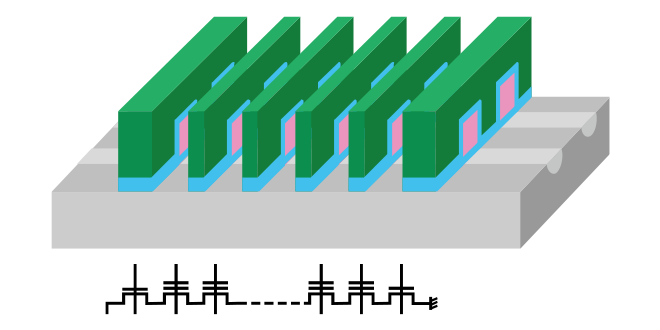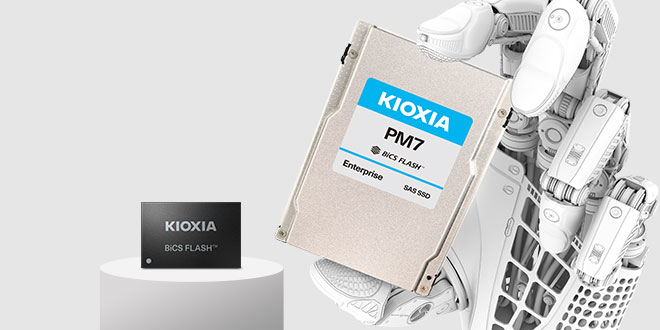Please select your location and preferred language where available.
What is NAND Flash Memory?
KIOXIA invented the world’s first NAND flash memory in 1987. This is an explanation of the structure of flash memory and the mechanism of data storage.
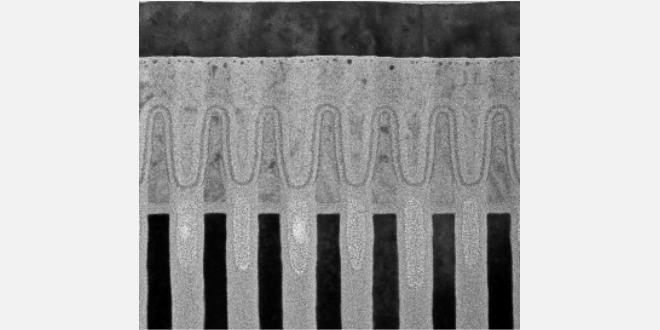
Flash memory is a semiconductor that stores data
Do you know what flash memory is?
Flash memory is a semiconductor that stores data. It is used in smartphones and many other electronic devices around us. KIOXIA invented the world’s first NAND flash memory in 1987 and remains one of the leading companies conducting flash memory development and manufacturing.
Of all the types of flash memory, NAND flash memory is the memory that has been used most widely in the world to this day.
Let’s take a look at what kind of thing flash memory is.
A smartphone is able to store various data such as text, images and music in flash memory because all the data is expressed as digital data using 0s and 1s.
For example, imagine that a photograph is being displayed on your smartphone (Figure 1). If we magnify this image and take a closer look, it is composed of a collection of dots (pixels). Each individual dot is composed of the three primary colors of light: red, green and blue. In digital data, the brightness of the light of each of these is adjusted in 256 levels with eight 0s and 1s (2 to the 8th power). In total, a combination of twenty four 0s and 1s can express around 16.77 million colors (red in 256 levels × green in 256 levels × blue in 256 levels). For example, the pink color in the photograph in Figure 1 is a combination of bright red light (11111111), dark green light (10000000) and bright blue light (11000000), so it can be stored as “111111111000000011000000”.
In this way, all of the data for the things like text, images and music that are stored in a smartphone are stored as a combination of 0s and 1s.

The structure of flash memory and the mechanism of data storage
Next is an explanation of the actual structure of flash memory and the mechanism of data storage. Figure 2 shows the memory cell structure (cross-section) of flash memory. Memory cells are the smallest unit of data storage. In recent years, flash memory has consisted of hundreds of billions of memory cells. Data is stored by moving electrons into and out from a charge storage film enclosed in an insulator.
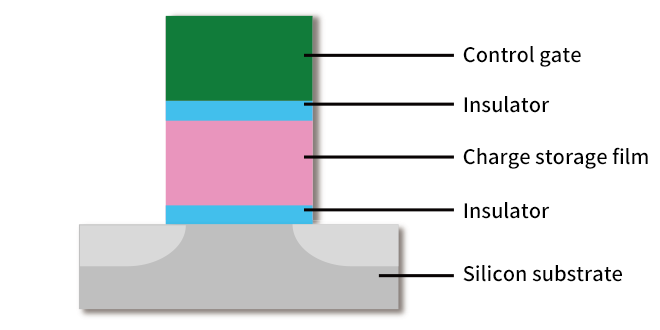
Figure 3 explains how the electrons are moved into and out from this charge storage film. When a high voltage (Vcg(++)) is applied to the control gate, the electrons pass through the insulator and enter the charge storage film from the silicon substrate (Figure 3(a)). When the power is turned off, this state of stored electrons remains. On the other hand, when a high voltage (Vw(++)) is applied on the silicon substrate side, the electrons pass through the insulator and go out from the charge storage film to the silicon substrate side (Figure 3(b)). As a result, the state created is that there are no electrons in the charge storage film. This is the operation to write and erase data in a memory cell.
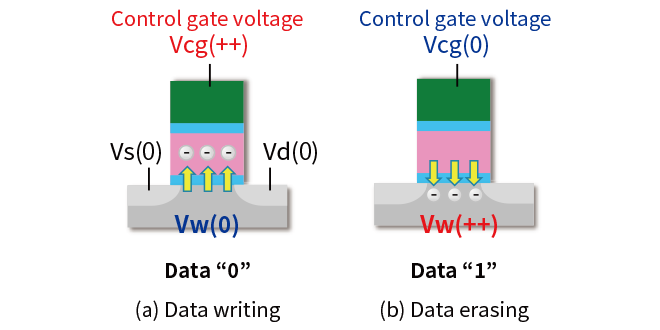
The determination of data “0” and “1”
Next is an explanation of the determination of data “0” and “1”. When a constant voltage (readout voltage Vcg(+)) is applied to the control gate, whether the data is a “0” or a “1” is determined by whether or not a current flows in the lateral direction of the memory cell (Figure 4(a)(b)). When a voltage is applied gradually to the control gate, the control gate voltage at which a current begins to flow in the memory cell is called the threshold voltage. (See the section on multi-level technology for details.) The judgment of “0” or “1” is performed by using the fact that this threshold voltage changes depending on whether or not there are electrons in the charge storage film. In the state where there are electrons in the charge storage film (data “0”), the threshold voltage is higher than the readout voltage Vcg(+), so the current does not flow (Figure 4(a)). On the other hand, in the state where there are no electrons in the charge storage film (data “1”), the threshold voltage is lower than the readout voltage Vcg(+), so a current flows (Figure 4(b)).
Even when the power supply is switched off, these “0” and “1” states are retained. This is the characteristic of flash memory that the data does not disappear even if the power is turned off.
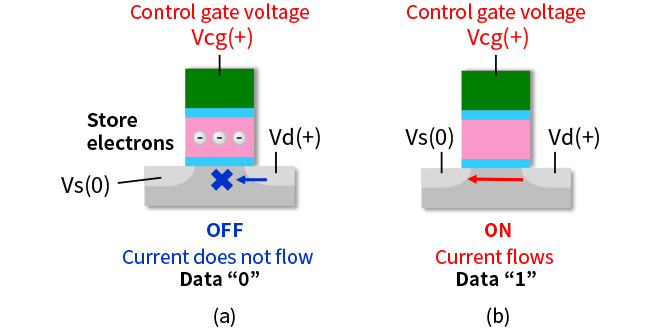
Memory with a structure that has these memory cells arranged in series as shown on Figure 5 is called NAND flash memory. A feature of NAND flash memory is that it is possible to arrange the memory cells with high density. It was used on the cards for digital cameras, and then, as the memory capacity increased, the applications and markets for it greatly expanded to portable music players, video cameras, mobile phones, smartphones and others.
